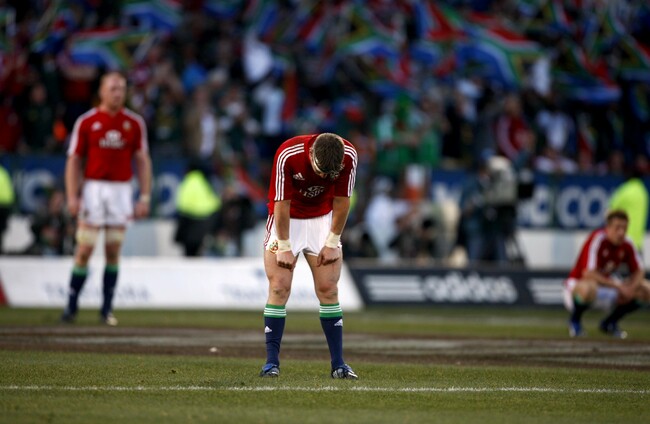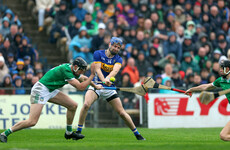THE FOLLOWING PASSAGE is an extract from Behind the Lions: Playing Rugby for the British & Irish Lions.
It is in many ways a strange thing that the popularity of the Lions amongst players and followers of rugby is as high as ever, despite the overwhelming number of desperate disappointments that have been suffered. Perhaps this says good things about the resilience in the spirits of British and Irish rugby people.
The scale of disappointment may be a personal matter which can only be judged in the individual heart and mind. But it is still somewhat doubtful if any Lions team has been as devastated, or as shockingly treated by fate, as the 2009 party during the Second Test on a warm day in Pretoria — an occasion which must arguably also rank as one of the most massive and awe-inspiring, not only in Lions history but in sport anywhere, for some time.
The Lions, needing a win to rescue the series, had turned in one of their greatest performances, and shut South Africa, the world champions, completely out of the game.
The Springboks had escaped censure after a disgraceful gouging incident by their flanker Schalk Burger led only to a yellow card; then the Lions were hit by what amounted to a double-double whammy, losing both their dominant props and both their illustrious centres within a few devastating minutes.
They held the lead into the last seconds until a moment of madness by Ronan O’Gara gave away the winning penalty to the Springboks. To say that the Lions were thunderstruck afterwards is a gross understatement, and there are players who to this day struggle to cope with the defeat. There are also Lions supporters having the same problem — on that day in Pretoria, there was the astonishing sight of a whole side of the grand old stadium at Loftus Versfeld packed and boiling in a sea of red.
If the final result of the series, 2-1 to the world champions, did not entirely suggest that British & Irish rugby was in the best of health, then the existence, and the concept of the Lions, was clearly still of quite stunning importance. And not least to South Africa itself, where the economy was boosted in remarkable numbers by the spending power of tens of thousands of British and Irish of all social classes and persuasions who poured into the country to follow their heroes.
In the aftermath, history will recognise the pride that was restored in the Lions jersey despite the 2-1 series loss. The people of South Africa embraced the tourists and many highly experienced players — such as Phil Vickery and Lee Mears — still rate the trip as the best of their careers. The Lions abandoned the fruitless kick-chase game that was prevalent in the domestic leagues of Europe, played some classic attacking rugby and were agonisingly close to success.
When Ian McGeechan, the head coach for the fourth time, arrived at the Landmark Hotel in London’s Marylebone in May 2008 the assembled gathering knew the future of the Lions was in safe hands. After the heart-breaking disappointment of 2001 in Australia under Graham Henry and the more drastic reversal in 2005 in New Zealand under Sir Clive Woodward it was only natural the Lions would turn to him.
Off the field things changed as well as the Lions went away from the claustrophobic model of the modern tour. McGeechan asked the players to become part of South Africa and to understand the country rather than be holed up in their hotel rooms playing video games — and they responded, even donating the fines from the players’ tour court to local charities.
There were coaching clinics for local children in impoverished townships where the players were greeted as heroes and, wonder of wonders, the Lions actually got out and about and saw a few of the local sights. In the build-up to the First Test match the Scotsman ensured the players ate where the fans ate so they could see the magnitude of the occasion coming up.
He also ensured there were no cliques — something which had dogged previous tours — by making the team room the hub of all activities and making separate players responsible for things such as discipline, music, golf days and outings. It was back to an old-school-type of tour and it was all the better for it.
The choice of manager was as sound as the coach he chose – with Gerald Davies, the urbane former Wales winger and a two-time Lion put in place. Davies loves the whole concept of the Lions and although he admitted winning was important on trips like this, he said it was not the only thing. He promised the players the experience of a lifetime. And they got it.
McGeechan’s backroom staff contained the guts of the Welsh coaching team with Warren Gatland, Shaun Edwards, Neil Jenkins and Rob Howley all travelling along with English scrum coach Graham Rowntree.
McGeechan’s captain was Paul O’Connell, the great Munster warrior, one of the few players who came out of the 2005 tour with his reputation intact and who had turned into one of the best locks in the world. It was a choice based on the same principles as that of Martin Johnson in 1997: a big man to loom large at the coin toss and to cast a dominant figure on the field.
Paul O’Connell: I came home one night and found five missed calls on my phone. There had been a guy on an English number trying to sell me shares over the last few weeks, so I was avoiding his call.
Then I saw the number again on the Tuesday morning. The voice on the other end said he was Ian McGeechan but I still wasn’t sure because we’ve got people at the club like Brian Carney and Frankie Sheahan who are always making crank calls.
This time I thought the accent was too good. Once I was sure, we had a chat and, straight out, he asked me to be captain and I said I’d be delighted to do it.
The results secured by Willie-John McBride and those fellas back in 1971 and 1974 has made all those players legends. The same can be said about the guys in ’89 and ’97. That was the goal that we all set ourselves — to join them in the history books.
A Lions tour of South Africa is the ultimate, the pinnacle for any player from the Four Home Nations. I wanted to make sure we do justice to the Lions jersey; I don’t think we did that in 2005. It was essential that we lived up to the tradition and history of the Lions. A lot of things went against us in 2005 but we did not do the tradition justice. That was a big motivation for me and for a lot of us who were on that tour. We saw 2009 as a big opportunity to put that right.
Ian McGechan: When the management board asked me to have one more crack at being Lions coach, I told them, ‘There are certain principles I think we have to work to. If you don’t agree with them, please don’t appoint me because I am not going to change my values.’
Those values meant improving the future by using the best of the past. Things like players sharing rooms, hanging out together, travelling together, really getting to know each other. It did not mean staying in one big centre in the country, flying in and out and never coming into contact with the country or its people.
I also wanted the players to understand the rugby – with one coaching team, one medical team and one strong management team that set an example to the players. In every way it was a blueprint put together from all my tours and all my experiences, good and bad.
The initial party for the 10-match tour comprised 37 players, a significant reduction from four years previously, and the balance between the Celtic nations and the English, which had been lopsided in New Zealand was redressed. Leinster, who had won the Heineken Cup that year, were represented by the likes of Brian O’Driscoll, Luke Fitzgerald, Rob Kearney and Jamie Heaslip, who along with Munster men such as O’Connell, Ronan O’Gara, David Wallace, Keith Earls and Donncha O’Callaghan gave the Irish a powerful presence in the squad.
The Welsh contingent included the massive trainee doctor and centre Jamie Roberts, who was to be the Lions’ man of the series, as well as, amongst others, Gethin Jenkins, Matthew Rees and Adam Jones, who would form an all-Welsh front-row in the Second Test. England flanker Tom Croft was considered unlucky to miss out on selection but by the time of the first match against South Africa in Durban he would be embedded in the Test side thanks to Alan Quinlan’s pre-tour suspension for foul play and his outstanding form in the early matches.
Croft improved immeasurably after a plea from McGeechan to get more involved in the game than he did with England or Leicester. A brilliant athlete and lineout forward, Croft often missed phases of play but on this trip the coach told him to roll up his sleeves and graft as well as doing the fancy stuff out wide and he did – to spectacular effect.
McGeechan also abandoned the principle of having a separate coaching team for the midweek side thus encouraging players that everyone was in the running for a Test place from the word go and that he had no preconceived ideas of what his best XV would look like.
But the Scot was hamstrung with injuries before the Lions had even left Pennyhill Park, their base near Bagshot, a luxury hotel that England use for national training. Irish hooker Jerry Flannery went lame, Welsh winger Leigh Halfpenny was struggling and centre Tom Shanklin and scrum-half Tomás O’Leary were other casualties.
Yet there was also the eternal question of the Lions place in the game at home. The players arrived immediately after major end of season games. Northampton would not even allow Euan Murray, their prop, to attend an administration session. Everything appertaining to proper preparation for a great rugby team had to be curtailed, short-circuited. It was a crying shame.
The list of injuries would, as ever, grow longer during a brutal tour and by the end of the trip James Robson, the Scottish doctor on his fifth Lions trip, would be questioning in a major media conference how long players’ bodies could stand up to the extreme demands of modern rugby.
McGeechan was also restricted by a fixture list that he had had no input in putting together, as the itinerary had been formalised before his appointment. Before the Second Test, for example, the Lions were forced to fly up to altitude without much time to get acclimatised, but typically they just got on with it. While they were playing at sea level in Cape Town, and flying up to altitude only 48 hours before the game, the Springboks had long been checked in to their Pretoria hotel. But such conditions are to be expected on a Lions tour – it has been ever thus. The players, management and backroom stuff just rolled up their sleeves and set out to give it the best crack they could.
Behind the Lions: Playing Rugby for the British & Irish Lions is published by Polaris. More info here.














Well that’s a depressing list,even my friend a LOI supporter is willing to go back to hoofball for results, why not give Delaney a call while we are at it
If I were the FAI I’d get onto Didi Hamman as he said he knows hundreds of people who would want the job!
@Aprior: Experts he met in the pub, sure we all know hundreds of them.
Damien Duff, hahaha!
Carsley would be exciting and given we have some great young players might be the right coach
For pure entertainment I wouldn’t be too unhappy if Keane got the job !